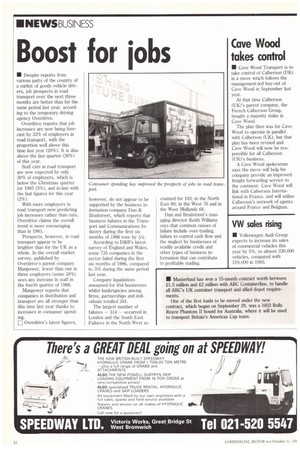Boost for jobs
Page 14

If you've noticed an error in this article please click here to report it so we can fix it.
• Despite reports from various parts of the country of a surfeit of goods vehicle drivers, job prospects in road transport over the next three months are better than for the same period last year, according to the temporary driving agency Overdrive.
Overdrive reports that job increases are now being forecast by 33% of employers in road transport, with the proportion well above this time last year (20%). It is also above the last quarter (30%) of this year.
Staff cuts in road transport are now expected by only 30% of employers, which is below the Christmas quarter for 1985 (5%), and in-line with the last figures for this year (2%).
With more employers in road transport now predicting job increases rather than cuts, Overdrive claims the overall trend is more encouraging than in 1985.
Prospects, however, in road transport appear to be brighter than for the UK as a whole. In the overall market survey, published by Overdrive's parent company Manpower, fewer than one in three employers (some 28%) sees any increase in staff in the fourth quarter of 1986.
Manpower reports that companies in distribution and transport are all stronger than this time last year thanks to increases in consumer spending.
Overdrive's latest figures, however, do not appear to be supported by the business information company Dun & Bradstreet, which reports that business failures in the Transport and Communications Industry during the first six months of 1986 rose by 5%.
According to D&B's latest survey of England and Wales, some 735 companies in the sector failed during the first six months of 1986, compared to 701 during the same period last year.
Company liquidations amounted for 454 businesses whilst bankruptcies among firms, partnerships and individuals totalled 281.
The largest number of failures — 314 — occurred in London and the South East. Failures in the North West ac
counted for 103; in the North East 80; in the West 76 and in the West Midlands 68.
Dun and Bradstreet's managing director Keith Williams says that common causes of failure include over-trading, failure to control cash flow and the neglect by businesses of readily available credit and other types of business information that can contribute to profitable trading.
























































































































